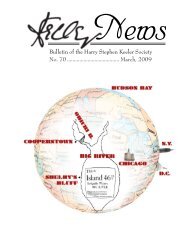John Newton Williams: The Untold Story - Personal Web Sites are ...
John Newton Williams: The Untold Story - Personal Web Sites are ...
John Newton Williams: The Untold Story - Personal Web Sites are ...
You also want an ePaper? Increase the reach of your titles
YUMPU automatically turns print PDFs into web optimized ePapers that Google loves.
ar action (misalignment, wear, and<br />
uneven key pressure or “touch” from<br />
row to row) and the assembly of the<br />
machine. In short, the central fea�<br />
tures of the machine, which were<br />
the novel ge<strong>are</strong>d type bar mecha�<br />
nism and the rocking carriage shift,<br />
proved its undoing. <strong>The</strong> contract had<br />
been signed in 1925, and the patents<br />
for workable improvements to the<br />
machine (as well as a number explic�<br />
itly stated as being for the purpose of<br />
reducing cost to the absolute mini�<br />
mum) were not granted until years<br />
later. <strong>The</strong> aforementioned “block” of<br />
thirteen improvements was granted<br />
patents in 1932; further would be<br />
added, one each in 1934 and 1935 (al�<br />
though none was filed after 1931.)<br />
<strong>The</strong> Victor Adding Machine<br />
Company picked the wrong design.<br />
Garbell’s ingenious design was too<br />
ingenious to debug. It All Adds Up in�<br />
dicates that only a few machines had<br />
been sold by 1929, and we may guess<br />
from the patents and other informa�<br />
tion that production probably didn’t<br />
last much longer than that. What’s<br />
more, Max Garbell had experienced<br />
two serious failures in a row, certain�<br />
ly a hard blow for this very bright<br />
man. ±<br />
Victor ad,<br />
<strong>The</strong> Literary Digest,<br />
December 10, 19 7<br />
Book Review<br />
<strong>John</strong> <strong>Newton</strong> <strong>Williams</strong>: <strong>The</strong> <strong>Untold</strong> <strong>Story</strong><br />
<strong>John</strong> <strong>Newton</strong> <strong>Williams</strong> is<br />
known to collectors as<br />
the inventor of the <strong>Williams</strong><br />
typewriter, with its ingenious<br />
“grasshopper” mechanism.<br />
But as this new book<br />
by Typex editor Mike Brown<br />
tells us, there is indeed an<br />
untold story. <strong>Williams</strong> (1840-<br />
1929) turns out to have been<br />
a busy and resourceful man.<br />
He fought in the Civil War,<br />
raced horses, and in addition<br />
to developing his typewriter<br />
invented machines such as a<br />
check punch, two- and threewheeled<br />
motorcycles, and a<br />
helicopter, hobnobbing with<br />
the likes of Alexander Graham<br />
Bell and Glenn Curtiss.<br />
by Michael A. Brown<br />
published by the author, 2005<br />
Photo by Glenn Curtiss, 190 :<br />
the <strong>Williams</strong> Helicopter “lifted this young<br />
man, several inches, several times.”<br />
I wish all histories were organized the way this one is. After a general<br />
summary of his findings, Mike divides the 188-page book into twenty<br />
chronological sections. Each section provides a timeline and a collection<br />
of relevant documents: photos, letters, legal papers, patents—even an ad<br />
in which Mr. <strong>Williams</strong> promotes Paine’s Celery Compound. This approach<br />
lets the reader delve directly into the sources. It’s almost like time travel<br />
as we follow <strong>Williams</strong> (and his magnificent moustache) through the Civil<br />
War, Reconstruction, the Gay Nineties, and the birth of aviation.<br />
We get to see a number of patent drawings, and learn that some aspects<br />
of the <strong>Williams</strong> typewriter keyboard <strong>are</strong> borrowed from the Fitch.<br />
<strong>The</strong> Phonographic World reported that <strong>Williams</strong> also based his design in<br />
part on the Slocum typewriter. Mike could not confirm this, but he does<br />
show us an ad for this very obscure machine.<br />
Mike was not able to track down some of the patents that <strong>are</strong> listed on<br />
the front of <strong>Williams</strong> typewriters; but with the help of Dirk Schumann’s<br />
wonderful “Patentbase” data DVD, most of these <strong>are</strong> easy to find—for example,<br />
the patent of April 30, 1878 is #202923, filed by Byron A. Brooks.<br />
(I will send a copy of the DVD to any ETCA member free upon request.)<br />
By the way, Mike reports that Brooks sued <strong>Williams</strong> in the 1890s, and<br />
speculates that lawsuits like this eventually contributed to the demise of<br />
the company.<br />
This book is the product of many years of research, and I recommend<br />
it to anyone who loves invention. Postpaid copies may be ordered for<br />
$30 (North America) or $37 (overseas) from Michael A. Brown, P.O. Box<br />
52607, Philadelphia, PA 19115.<br />
—Richard Polt<br />
ETCetera No. 73 / March 006 / 9





